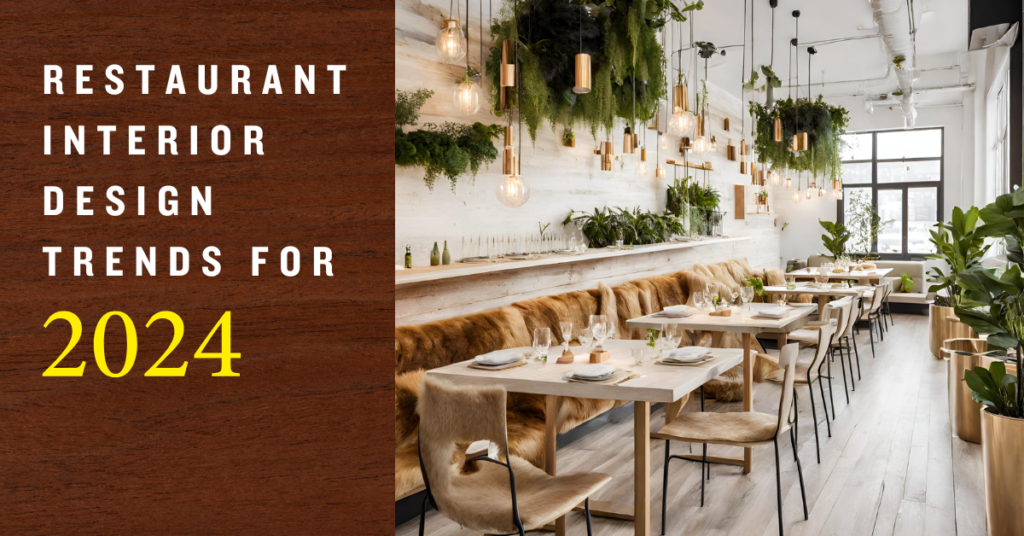The year 2024 paints a picture of a future where a fusion of creativity, sustainability, and technological prowess will greatly influence dining experience aesthetics. This is the future we see when we peer into the crystal ball of restaurant interior design trends. Future restaurant aesthetics are expected to be an exciting fusion of science and art, where the very rooms in which food is served elevate the dining experience. Guests will experience settings that represent the best in hotel design innovations, with every component thoughtfully chosen to augment the culinary experience.
In the fast-paced world of food culture, diners and epicureans look for settings that satisfy their senses viscerally and aurally in addition to their taste buds. It is anticipated that the interior design trends of 2024 will define and take dining to new levels of comfort and pleasure. Make sure every meal is an adventure that extends beyond the plate by staying up to date with the newest trends in restaurant decor for 2024.
Embracing Eco-friendly Materials in Restaurant Decor
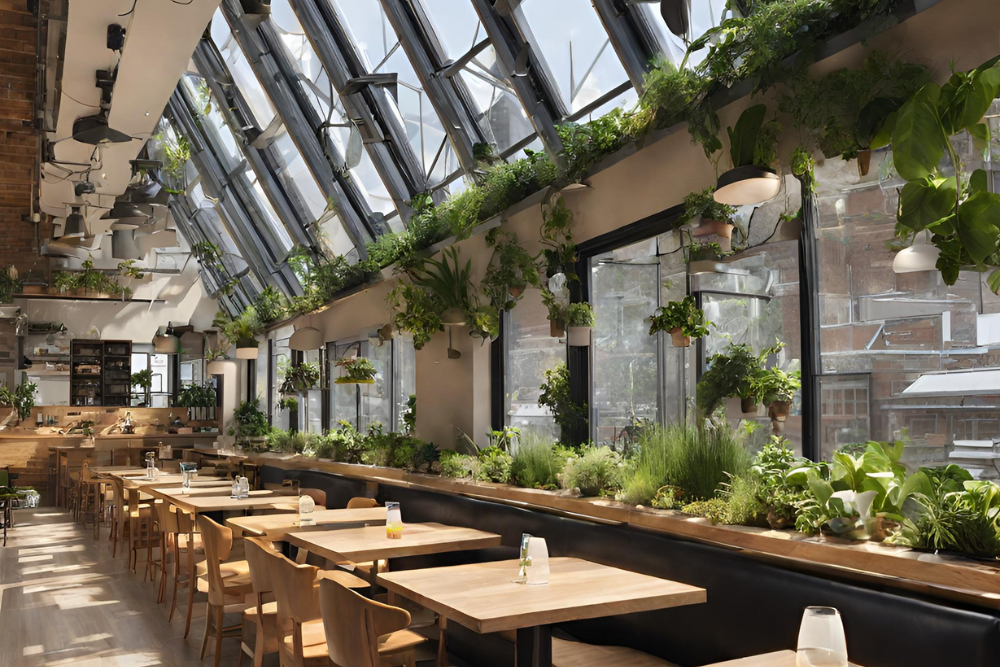
The dining landscape is being revolutionized by a robust movement towards sustainability, with restaurant interiors leading the charge. This embracement of eco-friendly materials goes beyond a mere trend; it is a tangible shift reflecting the collective consciousness of an environmentally aware clientele. A marriage of aesthetics and ethics, sustainable restaurant design is now a top priority for establishments that aim to reduce their carbon footprint while offering a feast for the eyes.
The Rise of Sustainable Furnishings
Sustainable restaurant design places equal emphasis on the furnishings that occupy the space as it does on energy efficiency. Well-made furniture made of materials that are responsibly sourced is now essential rather than a novelty. These pieces, each with its distinct grain and tale to tell, are frequently crafted from sustainable wood, bamboo, or even recycled plastic, each with its unique grain and story to tell. The cycle continues with each patron’s touch, where the green narrative is felt as much as it is seen.
Biophilic Design Elements
As our society gravitates toward urban spaces, the longing for a connection with nature intensifies. Biophilic design answers this call by introducing natural elements within restaurant spaces. Natural light, living walls, and plant installations are essential elements that contribute to a peaceful and well-being-infused environment. The concept of environmentally friendly design is highlighted by greenery-infused spaces, which not only clean the air but also help diners feel more connected to the food’s natural source.
Reclaimed Wood and Recycled Glass Accents
Integral to the charm of many modern eateries is the use of reclaimed materials in dining areas. Weathered wood from barns and historical structures inject warmth and tell tales of bygone eras. Countertops and bar shelves fashioned from recycled glass offer a glossy counterbalance, each fragment reflecting a commitment to the planet. Together, these materials create an environment rich with history and positive intentions, where every meal is served with a side of sustainability.
- Responsibly-sourced tables and chairs
- Recycled metal light fixtures
- Reclaimed wood flooring and bar fronts
- Countertops made from crushed recycled glass
It’s clear that the future of restaurant design hinges upon harmony—harmony between human-made structures and the natural environment, between what appeals to the senses and what is sensible for the planet. Biophilic elements and materials with past lives are now as crucial to a restaurant’s character as its cuisine, underscoring a deep commitment to ecological responsibility that resonates with today’s discerning diner.
Innovative Use of Lighting for Ambiance
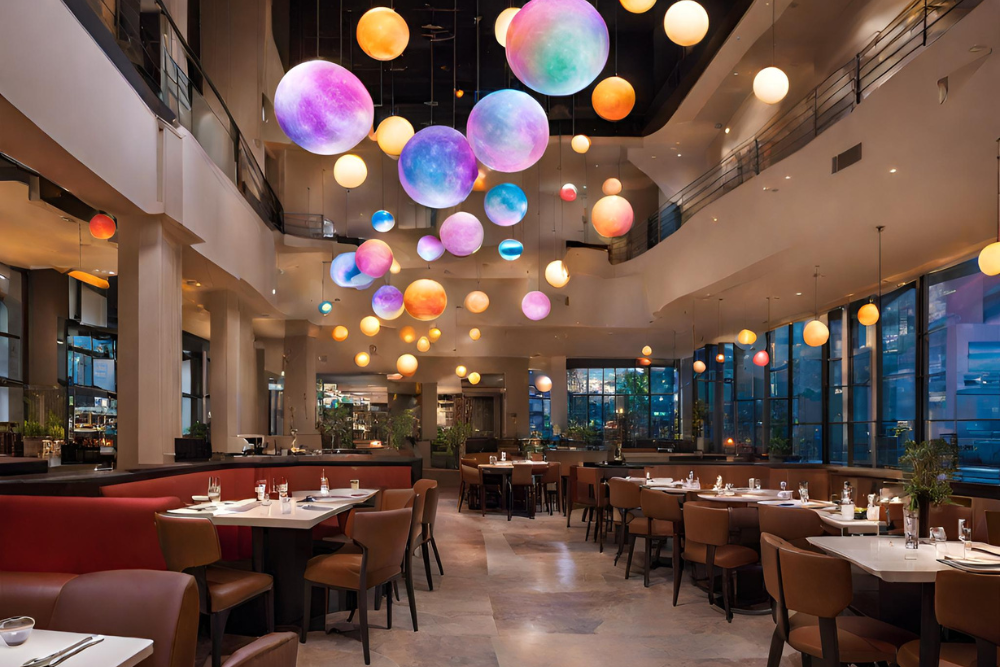
In a restaurant, the atmosphere is just as important as the food served. The emphasis on mood and atmosphere as we move into the future of dining décor has elevated creative lighting solutions to the fore of restaurant design. The newest styles make use of ambient lighting in restaurants to enhance the dining experience and draw customers in from the moment they arrive. By incorporating mood-based lighting design, LED lighting solutions, and interactive lighting, restaurants can create environments that embody their culinary philosophy and improve customer comfort and enjoyment.
Interactive Light Installations
Interactive lighting goes beyond illumination; it creates a dynamic environment that responds to the presence and interactions of diners. Imagine walls that change color with the rhythm of the music or tabletops that invite guests to set their lighting scene. These tactile experiences not only entertain but also immerse customers in a unique dining narrative, elevating a routine outing to an unforgettable culinary journey.
Energy-Efficient LED Solutions
Since LED lighting is a more environmentally friendly option than traditional lighting, it has completely changed the design of restaurants. LED lights not only use less energy but also last a very long time, which lowers overhead expenses and their negative effects on the environment. The versatility of LEDs allows them to fit any design theme, from warm, vintage-inspired bulbs to contemporary, color-changing arrays, all while maintaining high energy efficiency.
Customizable Mood Lighting Systems
The movement towards customized lighting is gaining momentum. Mood-based lighting systems can adapt to the time of day, type of event, or specific ambiance desired, offering complete control over the dining atmosphere. With technology that can shift the mood from a bright brunch to an intimate dinner with just a touch of a button, these innovative solutions put ambiance in the hands of the restaurateur.
| Feature | Benefits | Examples |
| Interactive Installations | Increased engagement, memorable experiences | Color-changing bar tops, interactive murals |
| LED Lighting | Energy-saving, long-lasting, versatile design options | Overhead LED spotlights, decorative LED chandeliers |
| Mood-based Lighting Design | Customizable ambiance, adaptable to restaurant events | Dimmable lights for dining areas, programmable systems for mood settings |
The Resurgence of Art Deco and Vintage Styles
In the world of restaurant interior design, there has been a discernible return to Art Deco and vintage aesthetics in recent years. These designs are well known for their capacity to create a retro aesthetic that whisks customers back in time to the opulent, luxurious restaurants of the 1920s. This renewed interest not only revives historical elegance but also enhances a unique dining ambiance that significantly influences customer perception and establishment identity.
The meticulous attention to geometric patterns, bold lines, and symmetrical designs are cornerstones of the Art Deco in dining decor, giving the spaces a sense of time-honored sophistication. Moreover, the insertion of vintage restaurant aesthetics adds a layer of warmth and charm that is both welcoming and comforting. Establishments integrating these classic designs are seen as trendsetters, reviving the glorious past with a modern touch.
- The geometric elegance of The Grill in New York City
- Maxine’s Bistro & Bar in Miami Beach, flaunting its glamorous vintage vibe
- The enchanting retro flair of The Cicada Restaurant in Los Angeles
Through a marriage of nostalgic decor and contemporary service, these venues have successfully set themselves apart, turning dining into a memorable time-traveling journey. The below table showcases some of the key components adopted by eateries to bring the Art Deco and vintage styles to life in their spaces.
| Design Element | Description | Impact on Dining Experience |
| Art Deco Lighting Fixtures | Chandeliers and sconces with geometrical shapes and metallic finishes. | Creates a dramatic, well-lit environment reminiscent of the roaring ’20s. |
| Vintage Wallpaper and Textiles | Patterns and fabrics that echo the past, often with floral and paisley prints. | Adds texture and warmth, contributing to a cozy and inviting atmosphere. |
| Retro Furniture | Pieces such as plush velvet seating or polished wooden tables resonate with the era. | Enhances comfort while maintaining the stylistic integrity of the period-themed decor. |
| Classic Color Palettes | Use of golds, greens, and deep reds to capture the luxurious essence of the period. | Stimulates visual appeal and a sense of regal elegance. |
This resurgence notably aligns with the broader retro design trend sweeping various facets of fashion and lifestyle. Diners not only look for culinary delight but also the overall experience and these design choices lead to greater customer satisfaction and loyalty. The infusion of Art Deco and vintage accents is not a mere nod to the past but a strategic enhancement of the brand’s narrative, catering to those who cherish a slice of history along with their meal.
Integrating Technology in Restaurant Interior Design
Digital design integration has emerged as a critical component in the development of cutting-edge dining experiences as restaurants adapt to the demands of the digital era. Within the food and beverage industry, technology is driving a new era of convenience and interaction from the point of entry to the very end of the dining experience.
Seamless Digital Ordering Experiences
One major innovation that’s changing the face of dining is the implementation of smart restaurant technology through digital ordering systems. These systems are not only enhancing customer convenience but are also reshaping restaurant layouts, as eateries allocate less space to traditional ordering counters and more to customer-centric dining areas.
AR-enhanced Dining Environments
Restaurants are starting to adopt augmented reality (AR), which transforms a routine meal into an immersive experience. These augmented reality experiences can be anything from interactive menus that show you a 3D representation of your meal before you place an order to narrative components that bring the history or culture of the food to life at the table.
Smart Tables and Digital Menus
The emergence of smart tables and digital menus has played a crucial role in streamlining service and personalizing dining. These innovations enable guests to place their orders, call the server, or even make payments directly from their tables—efficiencies that also help optimize the staff’s workflow.
| Technology | Benefits | Application in Dining |
| Digital Ordering Systems | Improved efficiency, reduced wait times | Ordering kiosks, mobile app integration |
| Augmented Reality (AR) | Enhanced customer engagement, interactive experiences | Visual menu previews, stories behind dishes/cuisine |
| Smart Tables | Streamlined service, increased guest control | Tabletop ordering, service calls, and payments |
| Digital Menus | Dynamic content, personalized recommendations | Interactive menu browsing, dietary customization |
Creating Immersive Theme-Based Dining Spaces
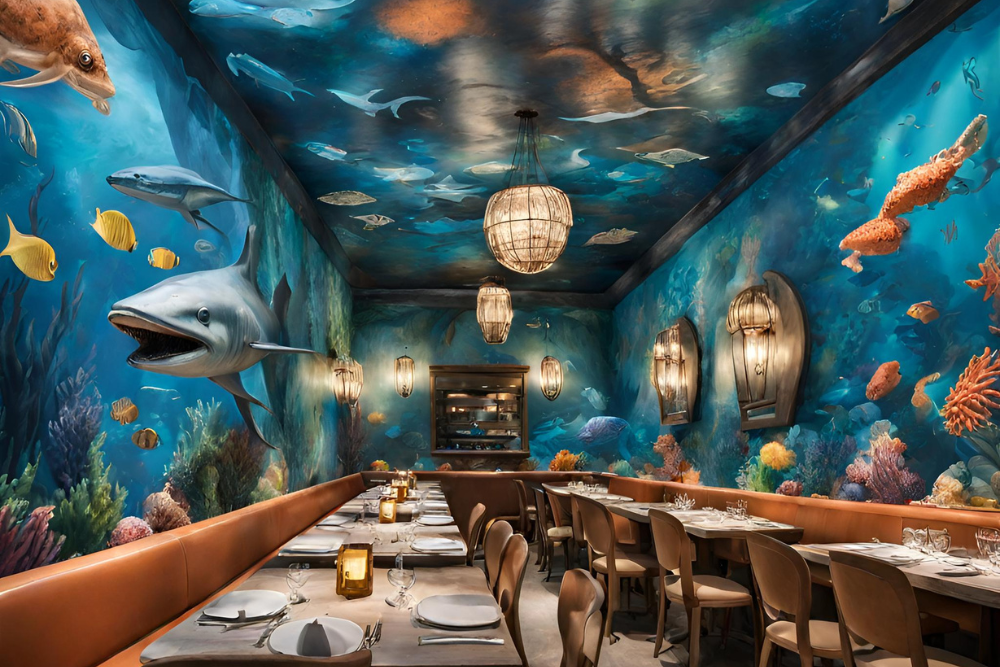
In today’s restaurant industry, stepping into a dining establishment is increasingly about experiencing a new world or story, with themed dining experiences taking center stage in providing an escape from the ordinary. By weaving story-driven restaurant design into the fabric of their space, restaurateurs tap into a deep-rooted human love for stories and experiences, making each meal about so much more than food.
Story-Driven Design Concepts
Story-driven design in restaurants goes beyond mere decoration, immersing guests in narratives that are rich and engaging. Restaurants with a theme driven by a strong story offer diners a sense of participation in the narrative, enhancing their connection to the space and to their dining companions.
Cultural and Historical Themes
Restaurants that embody cultural dining themes are not just places to eat; they are gateways to different times and places. These establishments often serve cuisine that is authentic to the region they represent, supported by decor elements that bring historical periods and traditions to life.
Niche Pop-Culture References
Meanwhile, pop-culture restaurants capitalize on the fervent followings of various entertainment mediums, from blockbuster films to beloved television shows. They create an environment where fans can revel in their shared enthusiasms, surrounded by the iconography and artistry of their chosen pop culture realms.
The table below highlights examples of themed restaurants and the unique elements they incorporate to create an immersive dining experience:
| Themed Restaurant | Type of Theme | Signature Design Elements | Inspired Cuisine |
| The Edison | Cultural/Industrial | Vintage-style decor, live entertainment | American Gastropub |
| Trader Vic’s | Historical/Tiki | Exotic cocktails, Polynesian artifacts | Island-inspired dishes |
| Sci-Fi Dine-In Theater | Pop-Culture/1950s Americana | Drive-in movie screens, retro car booths | Classic American meals |
| Oga’s Cantina | Pop-Culture/Star Wars | Intergalactic decor, themed cocktails | Galactic Snacks |
The Significance of Color Psychology in Restaurants
The strategic application of color in restaurant design serves as a silent communicator that can deeply influence diners’ emotions and behaviors. Understanding the role of color psychology in restaurant interior design is critical for crafting an environment that not only reflects the brand’s identity but also enhances the overall dining experience. Below, we explore how different palette choices for dining can either stimulate or calm the senses or even energize a fast-paced dining spot.
Choosing Color Schemes for Appetite Stimulation
Colors have been proven to affect our appetite and dining habits substantially. Warm tones such as red, orange, and yellow are renowned for their ability to energize a space and encourage appetite. These stimulating color schemes are often used strategically within restaurant interiors to create an inviting atmosphere that subtly nudges patrons to order more. For example, the use of red in fast-food chains is no coincidence; it’s a thoughtful design choice aimed at increasing customer turnover.
Calming Palettes for a Relaxed Dining Experience
In contrast to vibrant hues, calming restaurant interiors employ a different palette altogether. The use of gentle blues, greens, and lavenders creates a calm atmosphere that soothes diners. These colors are frequently connected to fine dining or health-focused establishments, where a calm setting is essential for a relaxing dining experience. They are more concerned with extending the stay and improving the enjoyment of a leisurely, expertly prepared meal than they are with arousing the appetite.
Energizing Colors for Fast Casual Spots
Fast-casual restaurants combine the casual dining experience with the quick service of fast-food chains. Interior color schemes are chosen to reflect this mood because they are energizing without being overpowering. Brighter palettes that include teal, tangerine, or lime can inject vivacity and fun into the dining space, encouraging a lively atmosphere that complements a swift but enjoyable meal.
| Color | Psychological Effect | Appropriate Dining Context |
| Red | Appetite stimulation | Fast Food, Casual Dining |
| Yellow | Energetic, Happy | Family Restaurants, Cafés |
| Green | Health, Relaxation | Organic Eateries, Vegan Cafes |
| Blue | Calming, Suppresses Appetite | Fine Dining, Seafood Restaurants |
| Orange | Comfort, Warmth | Diners, Ethnic Restaurants |
| Purple | Luxury, Creativity | Wine Bars, Boutique Restaurants |
Using color well is essential to creating a dining experience that people will remember. Color psychology is crucial to the design of successful restaurant spaces, whether the aim is to energize with playful, lively tones, relax with blues and greens, or stimulate appetite with vibrant reds and oranges.
Minimalism: A Continuing Trend in Restaurant Spaces
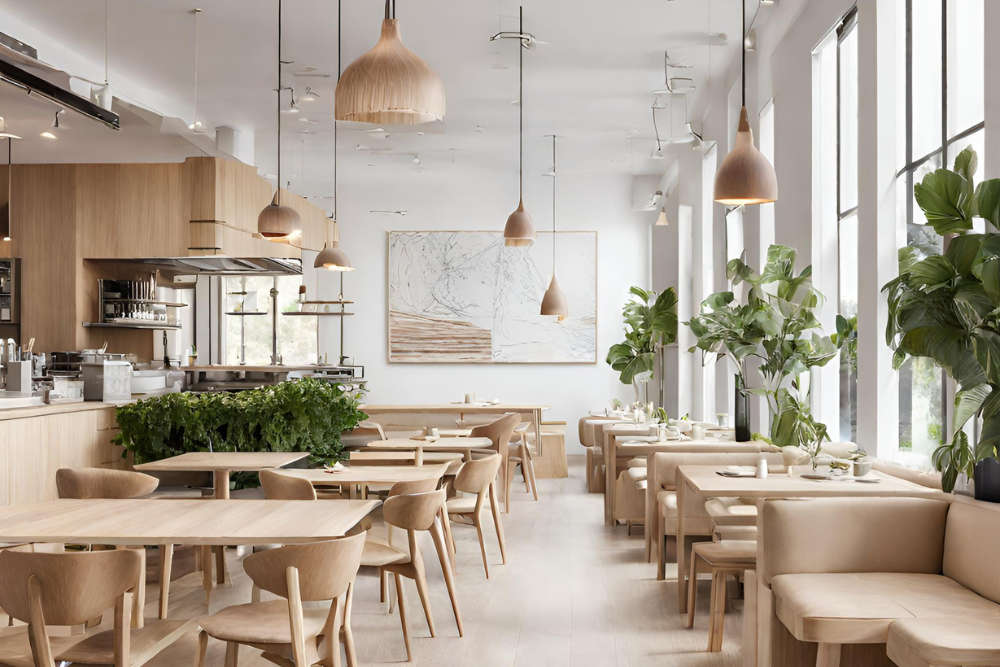
The key to minimalist restaurant interior design is its capacity to produce a calm, welcoming environment that elevates the dining experience. Restaurants are embracing a less-is-more strategy, showcasing straightforward restaurant interiors that prioritize quality over quantity, with an emphasis on clean dining aesthetics. This design concept is in complete harmony with modern minimalism, in which each component serves a function and advances the story of the eatery.
- The reduction of visual clutter allows the venue to resonate with patrons seeking a calming dining environment.
- The neutral color palettes often used in minimalist designs are not distracting, enabling the customer’s focus to remain on the culinary delights.
- Utilizing open space as a feature can make small restaurant interior design appear larger and more welcoming.
Adapting to minimalist design isn’t just about subtracting elements, but also about choosing the right components that embody both function and form. Furniture in a minimalist setting, for instance, is not only there to provide seating but also to complement the overall aesthetic.
| Design Element | Contribution to Minimalism | Visual Impact |
| Sleek, streamlined furniture | Reduces visual noise, promotes open space | Clean lines, unobtrusive presence |
| Neutral Color Palette | Enhances natural lighting and creates a calm atmosphere | Soft and inviting, allows other colors to pop |
| Natural Materials | Brings an organic, earthy feel to the environment | Textures and tones that speak of simplicity and quality |
| Strategic Lighting | Highlights architectural features, sets the mood | Creates drama and focus without being overpowering |
| Subtle Decorative Elements | Add layers of interest without clutter | Elegant accents that entice without overwhelming |
| Functional Space Usage | Maximizes guest comfort and flow of movement | Seamless interaction between the diner and the setting |
Adding minimalist design to restaurant spaces says more about the brand’s principles and commitment to offering a classy dining experience than it does about passing trends. Modern minimalism in restaurants today is defined by the philosophy of letting the food and service take center stage against a background of subtle elegance, rather than just aesthetics.
Maximizing Outdoor Spaces for Year-Round Dining
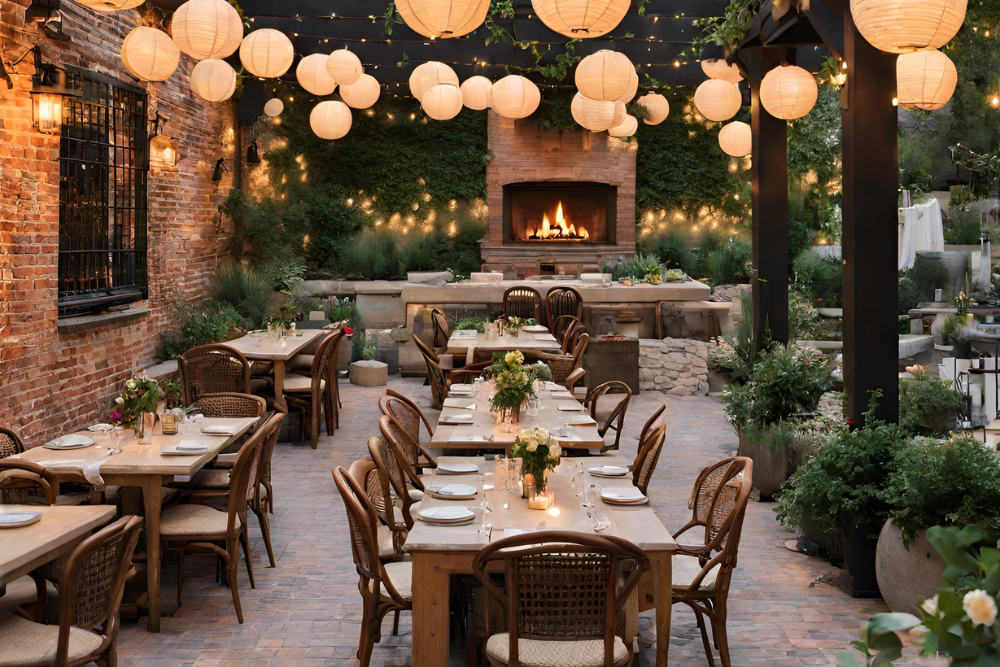
Restaurateurs are increasingly recognizing the lure of natural ambiance in enhancing dining experiences, leading to a surge in the creation of outdoor dining designs. This action not only increases a restaurant’s seating capacity but also satisfies patrons’ desire for outdoor dining. We explore the subtleties of creating patios and outdoor spaces that are functional, fashionable, and welcoming all year round.
Incorporating Heaters and Fire Pits
With the strategic placement of heaters and fire pits, establishments can transform their outdoor spaces into cozy, welcoming year-round patios. This creates an environment where patrons can dine under the stars even during cooler months, ensuring that those revenue-boosting picturesque views never go to waste.
Weather-Proof Furniture and Fixtures
Choosing the appropriate furniture is essential when creating weatherproof dining areas. Nowadays, restaurants are spending money on sturdy, weather-resistant tables and chairs that are comfortable without sacrificing design. These selections ensure longevity and offer a great return on investment thanks to their enduring nature.
Covered Patios and Retractable Roofs
For restaurants in regions with unpredictable climates, covered patios and retractable roofs are fundamental features allowing for adaptable outdoor restaurant areas. These innovative solutions provide shelter from adverse weather while still giving the option to bask in the sun on warmer days, effortlessly merging indoor luxury with the great outdoors.
| Feature | Benefits | Considerations |
| Heaters and Fire Pits | Adds warmth and ambiance; Extends dining hours into the night or cooler seasons | Energy efficiency; Safety regulations; Layout for optimal heat distribution |
| Weather-Proof Furniture | Durable through seasonal changes; Reduces long-term costs of maintenance | Material quality; Comfort; Aesthetic appeal that matches the restaurant’s theme |
| Covered Patios/Retractable Roofs | Offers flexibility for any weather; Expands usable space; Protects from UV rays and rain | Initial investment; Structural requirements; Ease of operation and maintenance |
Exploring Flexibility in Layout and Furniture Design
The modern restaurant landscape demands flexible restaurant layouts and adaptive furniture design to stay relevant and responsive to the ever-changing dining scene. Not only does this approach cater to the dynamic needs of a restaurant, but it also manifests a forward-thinking brand image that attracts contemporary customers.
Modular restaurant interiors are not just about aesthetics—though they play a significant part—they are about creating dynamic dining spaces that can be transformed effortlessly for different purposes. Be it a bustling breakfast period, an intimate dinner setting, or a large social event, the adaptability of the space is imperative.
- Adaptive layouts enable spaces to serve multiple functions—casual dining by day can transition to event hosting by night.
- Durable, reconfigurable furniture pieces reduce long-term costs and environmental impact by negating the need for frequent renovations.
- Flexibility leads to efficient use of space, maximizing square footage and allowing for various seating configurations.
Creative solutions, such as movable dividers and wheels on heavier furniture, contribute to the ease of transitioning the space. In the table below, we compare traditional and flexible design elements to outline their distinctive advantages:
| Design Element | Traditional Approach | Flexible/Modular Approach |
| Seating | Fixed booths and immovable chairs | Lightweight chairs and benches with variable configurations |
| Dividers | Permanent walls or static screens | Retractable walls and portable screens for dynamic space division |
| Tables | Large, heavy tables meant for static use | Compact, foldable, or extendable tables for easy movement and storage |
| Bar Area | Stationary bar counter | Modular bar sections that can be expanded or reduced |
Embracing adaptive furniture design and flexible layouts is not just a trend—it is an essential progression towards building a restaurant that can flourish in uncertain times. Take the leap to ensure your restaurant space is not just a place to eat but a versatile environment ready for whatever the future holds.
Conclusion
The future of restaurant design promises to push the boundaries of dining aesthetics, intertwining functionality with creativity. For restaurateurs aiming to craft a memorable brand identity and provide extraordinary culinary experiences, embracing new dining trends is not just an option but a necessity. We’ve witnessed how the thoughtful incorporation of innovative restaurant interiors can directly translate into increased customer satisfaction and loyalty.
As various trends unfold, from a renaissance of Art Deco opulence to the earthy allure of biophilic elements, each has the potential to elevate the art of hospitality. This transformation goes beyond mere visual appeal—elevating dining through design is about curating environments that speak to the senses, fostering a connection with guests that extends beyond the palate. Innovations in lighting, technology, and adaptable layouts offer restaurants a canvas upon which to project their unique stories and ambiance.
With the dining scene evolving rapidly, these design insights serve as a compass for navigating the intricate world of hospitality aesthetics. The establishments ready to integrate these insights into their spaces are poised to thrive. By doing so, they cater not just to the trends of today, but to the very essence of the dining experience, ensuring that every meal is an occasion and every visit is an imprint on the sensory memory of their guests.
FAQ
What are some anticipated restaurant design trends for 2024?
We anticipate a change in restaurant interior design towards creativity, sustainability, and technological advancements by 2024. Eco-friendly materials, the incorporation of digital elements, and creative lighting design to create mood are likely themes.
How is sustainability influencing restaurant decor?
There is a growing trend in restaurant decor to incorporate eco-friendly materials like recycled glass and reclaimed wood, emphasizing sustainability. As they incorporate natural elements into the dining experience, biophilic design elements are also becoming more and more popular because they promote well-being.
Can you give examples of how lighting is used to enhance ambiance in restaurants?
The mood that a restaurant creates is greatly influenced by its lighting. Examples include customer-engaging interactive light installations, economical and carbon-footprint-reducing LED solutions, and programmable mood lighting systems that adapt to the time of day or desired ambiance.
Why are Art Deco and vintage styles resurging in restaurant design?
Styles from the Art Deco and vintage eras are returning because they provide an opulent and nostalgic dining experience. By providing a distinctive look that can improve brand identity and customer perception, they are frequently used to set restaurants apart from one another.
What role does technology play in modern restaurant interiors?
Smart tables and digital menus streamline service, augmented reality (AR) improves the environment, and seamless digital ordering experiences are made possible by the growing integration of technology into restaurant design.
What makes themed dining spaces so appealing?
Themed dining spaces provide an immersive experience by using story-driven designs and reflecting cultural, historical, or pop-culture themes. Such environments create memorable experiences that go beyond dining, appealing to customers seeking connection and adventure.
How does color psychology impact restaurant design?
A crucial component of restaurant design that has the power to affect patrons’ emotions and appetites is color psychology. Colors can be chosen to energize the area, pique curiosity, or create a calm, relaxing atmosphere that complements the restaurant’s brand and intended dining experience.
What defines minimalist restaurant design?
Clean lines, muted hues, and uncluttered spaces are characteristics of minimalist restaurant design, which helps to direct customers’ attention toward the cuisine and service. This is a trend that appeals to people who value a sophisticated and concentrated dining experience.
How are restaurants adapting their outdoor spaces for year-round use?
To guarantee comfort throughout the year, restaurants are making the most of their outdoor areas by adding fire pits, heaters, and weatherproof furniture. Retractable roofs and covered patios are two examples of architectural innovations that are being used to increase seating capacity and adapt to changing weather.
Why is flexibility important in restaurant furniture and layout design?
Flexibility in layout and furniture design allows restaurants to adapt to different events and customer volumes, offering dynamic and modular interior arrangements. This adaptability can help maximize space efficiency and improve the overall dining experience.
